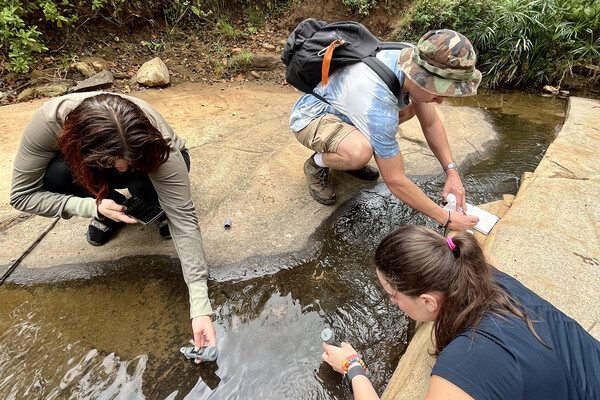
Griffin Pitt, right, works with two other student researchers to test the conductivity, total dissolved solids, salinity, and temperature of water below a sand dam in Kenya.
(Image: Courtesy of Griffin Pitt)
Greening vacant lots may be associated with biologic reductions in stress, according to a new study from the Perelman School of Medicine at the University of Pennsylvania. Residents who walked near newly greened vacant lots had significantly lower heart rates compared to walking near a blighted, or neglected, vacant lot.
“Our goal was to scientifically explore the connection between city environments and stress,” said the study’s lead author, Eugenia C. South, MD, MHSP, a physician in the department of Emergency Medicine at Penn. “We used heart rate as a physiologic marker of acute stress, and the reduction we found suggests a biological link between urban blight reduction strategies like vacant lot greening and reductions in stress.” The study, published online by the American Journal of Public Health, is the first known neighborhood walking trial in which a physiological marker was measured in real-time for residents in their own communities.
The researchers used a heart rate monitor with GPS to measure the stress response in study participants in two randomly selected Philadelphia neighborhoods as they went on a prescribed walk around their neighborhood. Vacant lots in one neighborhood randomly received a greening treatment, while the other neighborhood served as a control and received no treatment. Participants walked past vacant lots before, and then three months after, the greening treatment of randomly selected lots. The greening treatment, performed by the Pennsylvania Horticulture Society, is a low-cost environmental improvement that includes cleaning and removing debris, planting grass and trees, and installing a low wooden post-and-rail fence.
The average heart rate reduction attributable to being in view of the greened lots was over 5 beats per minute (bpm) lower than when near non-greened lots. In contrast, at the control site, there was minimal change in heart rate from the pre- to post-time period when walking past control lots versus non-study vacant lots. In a second analysis, the total net reduction of heart rate when near and in view of greened vacant lots was over 15 bpm. Walks ranged from about 1,500 to 2,000 feet in length.
These data support the conclusion that proximity to greened lots versus trash-strewn lots results in lower heart rates. In response to an acute stressor, the body activates the sympathetic nervous system, resulting in the release of epinephrine, which in turn increases heart rate. Thus, higher heart rates at unexpected moments and because of urban blight, which can be ubiquitous in some city neighborhoods, can be inferred to be evidence of stress. Heart rate change has been used in a few previous studies to evaluate acute stress response, although primarily in indoor laboratory settings.
The current research builds on previously published findings by South and her colleagues, which found that residents living near greened vacant lots feel safer than those near non-greened sites. "Our hypothesis in the earlier published work was that transforming vacant lots from being overrun with weeds and filled with trash to a clean and green space may make it difficult for people to hide weapons and conduct illegal activities such as drug use in or near the space. Thus the lower heart rate response we found in the newly published study may be tied to residents feeling safer and experiencing less stress from their environment.”
Click here to view the full release.
Greg Richter

Griffin Pitt, right, works with two other student researchers to test the conductivity, total dissolved solids, salinity, and temperature of water below a sand dam in Kenya.
(Image: Courtesy of Griffin Pitt)

Image: Andriy Onufriyenko via Getty Images

nocred

Provost John L. Jackson Jr.
nocred